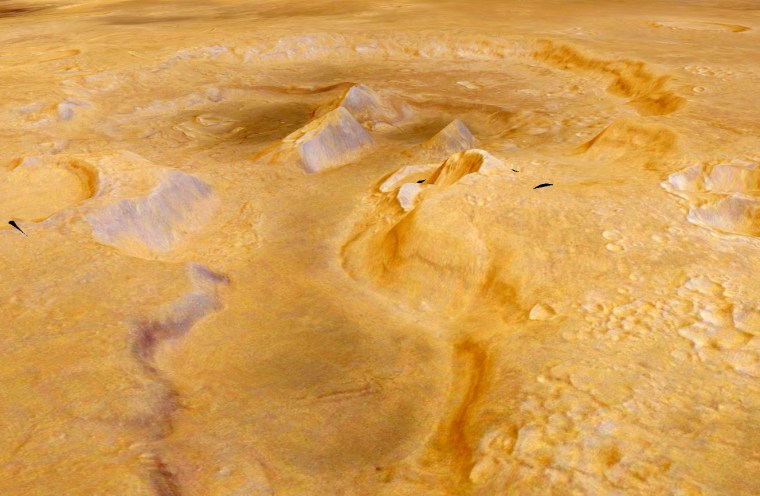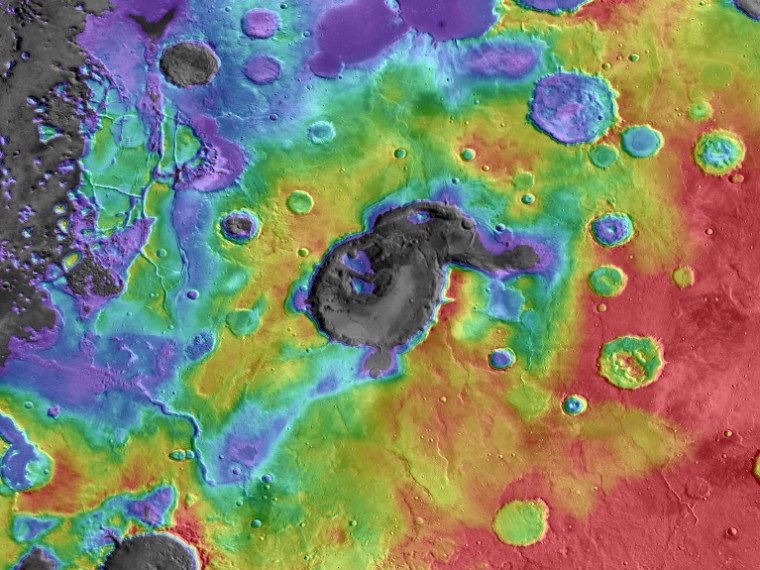Some of Mars' deep craters were actually ancient supervolcanoes that spewed ash over the Red Planet and probably changed its climate, researchers suggest in a controversial new study. The claim has met with resistance from other geologists, who say it's more likely the craters were created by meteor strikes.
"Yes, there is some resistance to the idea," one of the authors, Joseph Michalski of the Planetary Science Institute and London's Natural History Museum, told NBC News in an email. "That is perfectly natural for a totally new idea."
In this week's issue of the journal Nature, Michalski and co-author Jacob Bleacher of NASA's Goddard Space Flight Center say several irregularly shaped craters in Mars' Arabia Terra region have a structure similar to supervolcanoes on Earth, such as the hotspot that lies beneath Yellowstone National Park in Wyoming. Billions of years ago, each Martian supervolcano could have blasted out hundreds of cubic miles' worth of magma — so much material that the surface collapsed, leaving deep, irregular craters behind.
Solution to a Martian mystery?
That explosive activity could explain one of the mysteries about Mars: Why is there so much fine-grained powder deposited in layers on the planet? Scientists suspect that the deposits — including layered rock samples analyzed by NASA's Opportunity and Curiosity rovers — are composed of volcanic ash from an earlier era. But the dormant shield volcanoes seen on the Martian surface today couldn't have produced that much material.
Michalski said he lit upon the potential solution to the mystery while he was studying groups of Martian craters. To his eye, some of those craters just didn't look as if they were formed by cosmic blasts from above.
The supervolcano candidates listed in the Nature paper include Eden Patera as well as Siloe, Euphrates, Ismenia and Oxus Patera. Michalski and Bleacher say these features don't fit their criteria for impact craters — in part because they don't have well-defined rims or evidence of impact debris, and are too deep to fit the profile for eroded ancient craters. They say more such features might be found elsewhere on Mars.
"It makes sense that supervolcanoes might have been more common on ancient Mars, particularly if the ancient crust was thinner than it is now," Michalski said in a Natural History Museum news release. "This would allow magma to rise to the surface more quickly, before it could release gases within the crust. If future work shows that supervolcanoes were present more widely on ancient Mars, it would completely change estimates of how the atmosphere formed from volcanic gases, how sediments formed from volcanic ash and how habitable the surface might have been."
Such eruptions could have cooled the Martian climate if they contained large amounts of ash and aerosols, like the 1991 eruption of Mount Pinatubo in the Philippines. It's also possible for eruptions to have a warming effect, perhaps like the blasts that coincided with a mass extinction on Earth 250 million years ago.
Michalski said the supervolcano hypothesis is "not in accord or disaccord" with the Curiosity rover team's claim that Mars was far more habitable billions of years ago. "When the rover arrives at Mount Sharp — the massive mound of sediments in the center of Gale Crater — we hope the team can test the hypothesis to see if they find evidence for ash beds interlayered with rocks in the mound," he told NBC News.

Skeptical view
Not everyone is convinced that the hypothesis holds up. "My reading is that it's speculation piled upon speculation," Shan de Silva, a volcanologist at Oregon State University, told NBC News. "I'm not convinced that these are volcanic. They're interesting features, but none of the criteria that they use to eliminate impact craters is definitive. If it's not volcanic, why are we even talking about this being a supervolcano?"
He disagreed with the assessment in the Nature paper that the craters couldn't possibly have been caused by cosmic impacts. "If you plot the impact craters, they fall exactly where these things are," he said.
De Silva gave Michalski and Bleacher credit for trying to solve the mystery that surrounds Mars' volcanic deposits. "But they're making a huge leap that it has to be a certain type of feature that's found on Earth," he added.
"Many big eruptions actually happen from tectonic features, or lineaments, or fissures that are easily masked by their deposits," De Silva said. "The key here is that we need to be careful finding Earth analogs for features on Mars."
Michalski said he and his colleagues have been presenting the volcano hypothesis at scientific meetings for years, and he accepts the fact that the claims are controversial.
"In fact, we prefer to meet some resistance, because it is this vigorous debate that ultimately results in better science results long term," he said in his email. "It is our sincere hope that people will give it a fair shake and try to disprove the idea. That being said, we have thought through the ideas over some years, and we stand behind the conclusions presented in the paper."
More about volcanoes on Mars:
- Martian volcanoes may still be ready to rumble
- Ancient volcanic blast hints at Mars' wet history
- Martian dirt reminds scientists of Hawaiian volcanic soil
Alan Boyle is NBCNews.com's science editor. Connect with the Cosmic Log community by "liking" the NBC News Science Facebook page, following @b0yle on Twitter and adding +Alan Boyle to your Google+ circles. To keep up with NBCNews.com's stories about science and space, sign up for the Tech & Science newsletter, delivered to your email in-box every weekday. You can also check out "The Case for Pluto," my book about the controversial dwarf planet and the search for new worlds.
